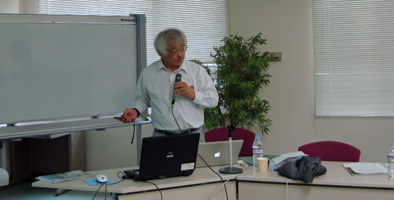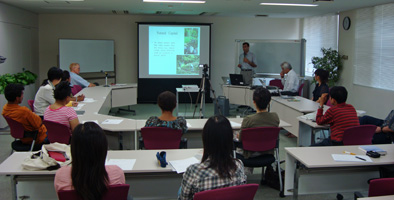- HOME
- NOTICES
- Dr. NAKAMURA Koji & Dr. Kazem VAFADARI(Kanazawa University) gives a lecture at a RCAPS Seminar:
Dr. NAKAMURA Koji & Dr. Kazem VAFADARI(Kanazawa University) gives a lecture at a RCAPS Seminar:

On Friday July 23, a RCAPS sponsored seminar was held at APU.
The seminar welcomed Dr. NAKAMURA Koji & Dr. Kazem VAFADARI(Kanazawa University) to give a lecture titled, "Community-Based Tourism Promotion in Japanese Villages: A Sustainable Rural Livelihood Approach for Mountainous and Costal landscapes of Satoyama and Satoumi".
At the invitation of Professor Malcolm Cooper, Dr. Nakamura and Dr. Vafadari explained about the sustainable rural livelihood approach, based on tourism, to revive the traditional rural landscapes of Japan. After a brief explanation of the distribution and characteristics of Satoyama landscapes in Japan, Dr. Nakamura talked about the major problems in the satoyama landscapes. Depopulation in the mountainous areas, urban expansions, improper management, chemical pollution, and invasion of alien species, according to Dr. Nakamura, are some of the major problems that the present satoyama landscapes are facing today. Dr. Nakamura went on to explain about the Japan Satoyama and Satoumi Sub global Assessment, as a part of the "Satoyama Initiative" taken by the Ministry of Environment in Japan as a sub global assessment to the Millennium Ecosystem Assessment. Dr. Nakamura stressed on the study on the linkages between ecosystem services and human well being, and integration between these two. This, he said, would be a new way to study traditional rural landscapes in Japan. Following Dr. Nakamura's presentation, Dr. Vafadari explained about Sustainable Livelihood Approach or SLA through tourism, which will be a 'new business practice' for the revitalization of satoyama.
Dr. Vafadari further explained about the consideration and assessment of different types of capitals such as human, economic, natural, social etc, and stressed especially on institutional capital and how it can be linked with other capitals to increase the attraction of the satoyama landscapes from a tourism point of view. This attraction should be introduced to the urban areas, with easy access to tourist markets and access and participation in the policymaking processes. But the most important thing is how rural people feel about their benefit from the tourism activities, and how their informal rules are integrated in the policymaking process. According to Dr. Vafadari, given that these considerations are well explored, sustainable livelihood through economic gains from tourism can protect local cultural and natural resources that are unique in satoyama landscapes. The presentations were followed by a lively discussion with the audience who received valuable research insights from both the speakers.
CHAKRABORTY, Shamik Doctoral Candidate, Graduate School of Asia Pacific Studies
Video(WMV)

- TOPIC
- セミナー

